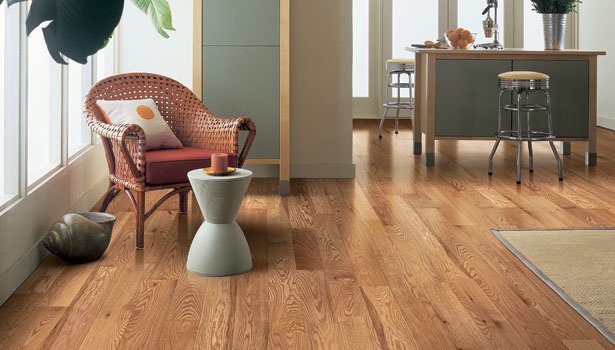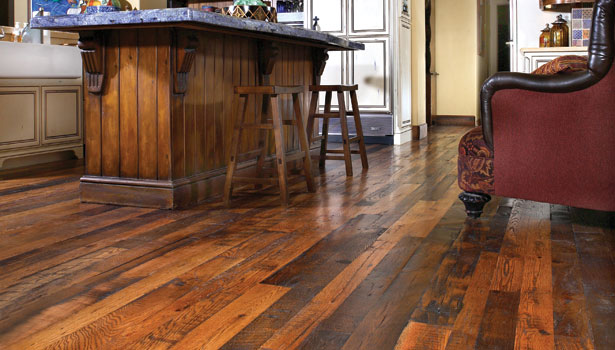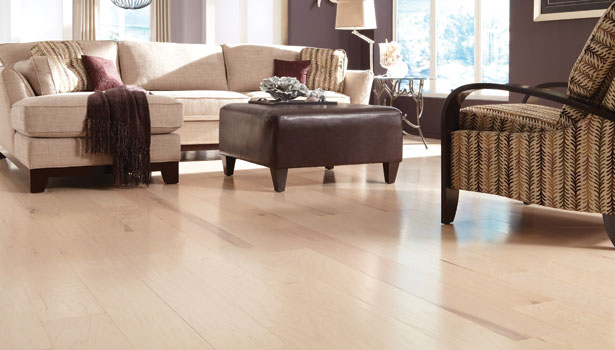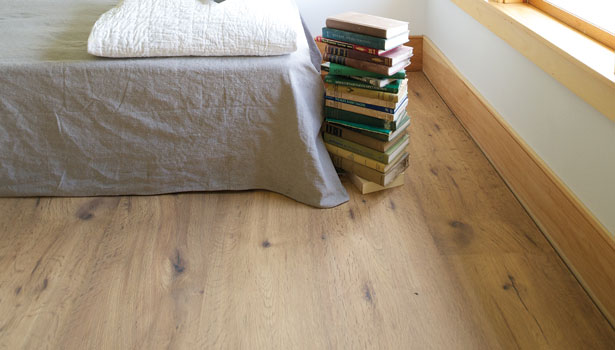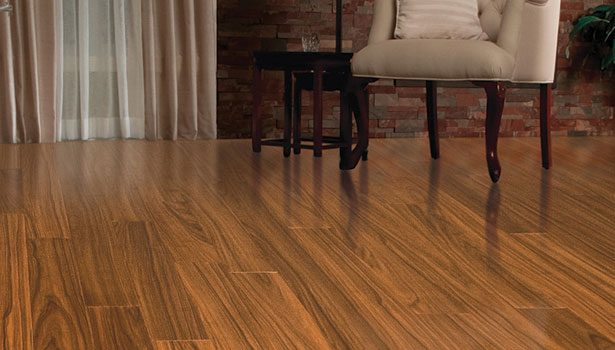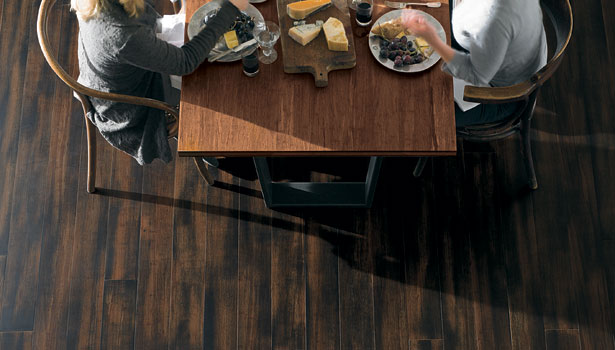Selling the Green Aspects of Hardwood Flooring
















It is hard to argue that hardwood flooring, derived from rapidly renewable trees, is one of the greenest floor covering options available. But is it worth selling that aspect of the floor? For residential consumers, a floor’s sustainable attributes usually come after its look, price and durability, but the reality is salespeople should always take the time to present the product’s green story.
Milton Goodwin, Armstrong’s vice president, hardwood product management, said the best way to sell a product’s sustainable attributes is by simply stating the facts: “Clearly call out the floor’s key attributes for your customers that drive value.” He also recommends “using engaging merchandising displays that are easy to navigate and support regional preferences.”
Goodwin believes it is important to talk about the durability of the flooring as well as the legacy of the manufacturer. “Products that have long lifetimes result in less impact on the environment since fewer raw materials, less transportation and lower embodied energy are used. The best way to educate buyers is to steer them to trusted brands with a legacy of sustainable practices. Great brands are tremendous assets to retailers.”
Armstrong has sponsored the planting of more than 1.5 million trees, and all of the company’s engineered hardwood products meet emissions requirements under the California Air Resources Board (CARB) Airborne Toxic Control Measure to Reduce Formaldehyde Emissions from Composite Wood Products, he added.
Retailers should also have a basic understanding of how the floor will be installed, so they can talk to customers about low-VOC adhesives and alternative methods that might not require the use of any glue. “Most engineered wood can be installed without adhesives, using lock, staple and float techniques. Also, with pre-finished solid and engineered floors, no site-finishing minimizes the amount of VOCs released into the home,” Goodwin explained.
One common debate in the industry is the relative green qualities of solid compared to engineered wood flooring. Unlike engineered, solid products require no adhesives in their manufacture. David Wilkerson, Shaw Industries’ corporate director of sustainability and product stewardship, said engineered hardwood still offers several environmental benefits, including “reduced requirements for newly harvested wood, more efficient use of the whole tree and minimization of waste.”
He added the sustainable aspects of engineered wood flooring should be part of the discussion when selling consumers on the versatility and performance characteristics of the product. “Whether they realize it or not, as consumers consider performance, design and value, they are in fact considering sustainability.”
Wilkerson noted more than 60% of Shaw’s sales are from Cradle to Cradle Silver certified products. “As we work toward our goal to design all our products to Cradle to Cradle protocols by 2030, our company, our customer and our communities benefit from this rigorous, holistic approach.”
Tammy Perez, Mohawk Industries’ senior brand manager for hard surfaces, pointed out how consumers expect leading manufacturers to offer sustainable products and follow sustainable business practices. “The importance of purchasing green products can vary by region, but many consumers care about how their products are made and where they come from.”
She noted Mohawk’s engineered hardwoods feature PureBond technology, which “replaces urea formaldehyde adhesives traditionally used in the manufacture of composite wood products. Additionally, select engineered products are FloorScore certified for compliance with rigorous indoor air quality emissions requirements.”
Sales training is a vital step in making sure a product’s green attributes are relayed correctly. “Mohawk works diligently to ensure our sales force, retailers and retail sales associates are educated on the green attributes of our floors,” Perez said.
Brian Greenwell, Mullican Flooring’s vice president of sales and marketing, said one easy way to ensure a product is sustainably harvested from a forest that meets the standards of the Forest Stewardship Council (FSC) is to buy domestic, noting “All wood flooring manufactured in the United States is considered green.”
He added domestic manufacturers use adhesives without added formaldehyde in the construction of engineered hardwood flooring, but there is no guarantee of lower formaldehyde levels with overseas producers.
“Retailers should have a clear understanding of the various third-party organizations and certification programs that exist for the flooring industry,” Greenwell stated. “Having this knowledge allows retailers to engage customers in discussions of greater depth and breadth. We have learned, retailers who strategically place literature and signage near product displays tend to generate increased customer interest in the environmental benefits of hardwood flooring.”
Along with holding FSC certification for its products and processes, Mullican’s sustainability efforts include helping create the National Wood Flooring Association’s (NWFA) Responsible Procurement Program that signifies a manufacturer’s commitment to environmentally and socially responsible products, as well as voluntary participation in Appalachian Hardwood Manufacturers, Inc.’s verified sustainable program.
Wade Bondrowski, Mercier Wood Flooring’s director of U.S. sales, said another consideration when choosing a green product lies in the finish itself. “Mercier has eliminated its dependence on petroleum, and has switched to soybean oil. This leads to virtually no off-gassing, and we have GreenGuard certification.”
He said the retailer has the power to sway a consumer’s decision, but only with the proper education and sales training. “That starts with the industry making the retailer more aware of which manufacturers are accountable and believe in the green movement. Green among consumers is still in its neophyte stages, but we believe in time the decision will become a primary consideration as the consumer becomes more educated and aware of her flooring purchases.”
Gary Keeble Jr., USFloors’ product and marketing manager, echoed those sentiments. “It is up to the supplier to train the retail sales associate so they have a comfort level to communicate the benefits as the consumer’s expert consultant.”
He noted third-party certifications such as FSC and GreenGuard are the best ways to protect against greenwashing—that is, the practice among some manufacturers to boast their products are green without backing it up with verifiable facts or standards.
Working with a manufacturer that is well-versed in sustainability is also a benefit, Keeble added.
“Any certification programs or green claims that do not include third-party certification should be carefully reviewed,” cautioned Michael Martin, NWFA’s president and CEO.
Among the certifications to look for include: FSC, NWFA Responsible Procurement Program and American Tree Farm System, he said.
Martin added retailers are usually well-informed about the green attributes of wood flooring and low-VOC products and adhesives. “Retailers have to be informed to be in compliance with local and federal laws, including CARB, new EPA formaldehyde regulations and so on.”
When talking about the green attributes of wood flooring, one key point should be stressed: “Wood floors coming from a renewable resource should be the primary conversation,” Martin noted. “Some may argue that it takes 40 to 60 years for a hardwood tree to mature, but since wood floors can be expected to last in excess of 100 years when properly maintained, the inventory will be available long before it is needed.”
Cork and Bamboo Offer Their Own Green Stories
By Michael Chmielecki, Associate Editor
Cork and bamboo inhabit a niche space in the hardwood flooring market. Cork, which is harvested from the bark of the cork oak tree, is technically both a hardwood and a resilient. Bamboo, on the other hand, is technically a woody grass. However they’re categorized, both deserve a second look among retailers seeking to offer a variety of green hardwood flooring products.
Tim Tompkins, Amorim Flooring North America’s national marketing director, said people often don’t understand cork is a wood product with a list of green attributes. “The best way to educate them is through improved in-store P-O-P for the consumer, and sales training offered to the retail salesperson selling our product on the floor.”
He believes retailers should create special boutique areas in their stores highlighting the green flooring options. “They should dedicate certain amounts of display areas to environmentally friendly products. By doing so they can add a nice profit center to their business.”
He also thinks that retailers should call out any third-party certifications that a manufacturer or product has received. “The GreenGuard label certifying products that have qualified for the rating through independent testing is a good one to identify in-store.”
Ann Wicander, WE Cork’s president, also believes retailers should highlight and promote their green products. “The best method is to use a visual indicator marking the product line as green. Start with creating a point system that determines what green attributes the products provide. Mark them accordingly, maybe in different shades of green. The more green points, the greener the label.”
She said not only does this help the consumer become aware of what products are better for the environment, but in addition “dealers who use this kind of system have been very successful in clarifying against greenwashing.”
She noted WE Cork’s makes the green attributes of cork a key part of its presentation to dealers. “There are still some dealers who do not know that cork is only the bark and that the tree is not harmed during removal. They do not know that it is rapidly renewable, with the bark being removed every nine years from the same tree. For our floating floors, we use VOC-compliant binders that meet LEED requirements for air quality.”
John Austin, Strategic International’s vice president of sales, said bamboo scores high in all green attributes, including environmental sustainability, durability and indoor air quality.
“Bamboo is harvested, in most cases, at five years of age,” he explained. “The next spring, a new bamboo shoot emerges on the same root. Regarding durability, strand bamboo flooring is much harder than all domestic hardwood species. As for indoor air quality, while bamboo flooring is manufactured with adhesives as with all engineered hardwood flooring, manufacturers with third-party certifications provide peace of mind.”
Austin recommended retailers steer consumers to a quality product, such as Strategic’s Trillium brand. “To seize on the green aspects of bamboo, it must be of good quality and have a long-life expectancy in the home to truly fulfill the environmental pluses of a rapidly renewable fiber.”
Steve Wagner, Wellmade Performance Floors’ director of sales and marketing, also believes in selecting high-quality products. “Wellmade sources only Moso bamboo, recognized as the highest-quality raw material for bamboo flooring,”
He explained. “Wellmade also uses ultra-low VOC adhesives and resins that exceed the European E1 Standard for low formaldehyde emissions.”
Wellmade bamboo flooring has also earned FloorScore certification, Wagner added.
He said educating retail salespeople on the green aspects of bamboo is important. “Wellmade has developed excellent P-O-P merchandising and marketing materials that clearly define key environmental attributes of our bamboo floors.”
Caitlyn Kari, Teragren’s marketing communications manager, said installation adhesives and their impact on indoor air quality is a concern among the company’s customers. “That is one reason why our products that can be glued down can also be nailed, stapled or floated. We have had several customers in the past few months specifically request an adhesive-free installation.”
She noted Teragren also looks carefully at how its products, with raw materials grown in China, are transported. “Teragren works with the Clean Cargo Group and SmartWay transport carriers to make sure the transportation footprint of our products is as low as possible from source to installation, and due to the inherent carbon-capture properties of bamboo, most Teragren flooring installations in North America are ultimately carbon negative when looking at the full [life] cycle.”
The company has recently launched the Bamboo Essentials training program for retailers to help them understand the green attributes of the product. “We recommend knowing which standard is the best—such as CA 01350 for indoor air quality—and then making sure to understand which certifications support that standard, for example FloorScore,” Kari explained. “This also comes down to brand integrity and trust. If the brand has been in the market for a long time and retailers are familiar with it, that goes a long way.”
Looking for a reprint of this article?
From high-res PDFs to custom plaques, order your copy today!







